As we meandered through the streets of the Karakoy neighborhood of Istanbul, Avraham (among others on separate occasions) told me something rather intriguing: Karakoy was one of the areas of Istanbul where the Karaites used to live – and in fact some people believe that Karakoy takes its name from the historical Karaite Jewish community.
I found this rather hard to believe. Could it really be that there were once so many Karaites in Istanbul, that an entire neighborhood was named after them?
Strange as it may seem, this now rapidly shrinking community was indeed a pillar of historic Istanbul (then known as Constantinople or Kushta/Konshtandina in Hebrew). And as much as I – in 2015 – could not fathom that Karaites were this numerous, it is quite possibly the case that Karakoy, which means “dark village” in Turkish, actually derives its name from the Karaites (Karay, in Turkish) and really means Karaite village.[1] I don’t personally believe this – but is is possible.
That’s pretty crazy. But not nearly as crazy as some of the other stories I heard.
I should probably give you some background on Avraham before I continue. He is (in many ways) the Turkish equivalent of me: just some guy trying to document Karaite knowledge for posterity. He even hosts a Karaite blog in Turkish – which started off with a focus on the Karaite language spoken in Turkey, but has since evolved into a blog on all things Karaite. And I pray that he posts more regularly.
He is also full of wisdom. I asked him whether he thought the Karaite philosophy would survive another generation. He was adamant in his response: “Deep in the heart of every Jew, you will find some Karaite views.” I also lamented that he and I arrived about 15-20 years too late, and we may have already lost a lot of the current Karaites. To which he responded, “If we are too late, then why did God put us here in this generation.” We both chuckled at how Hassidic this sounded. But it is true. And beautiful.
Anyway, back to our tour. After visiting the Italian synagogue in Karakoy, we made our way over to the Karaite synagogue in the Hoskoy region.
The Karaite synagogue has frankly seen better days, but it is still magnificent. The community ceased holding regular Shabbat services a few years ago. Today, the synagogue is only opened on moadim and other special occasions. But the people who met me there were among the warmest and kindest people I have ever encountered.
The Hoskoy region also used to be the home to other Jewish communities. About a 45 second walk from the Karaite synagogue, Avraham tells me there is an abandoned Romaniote synagogue and mikveh. On the entrance to the building, you can see Hebrew letters Kof-Kof, which stands for Kahal Kadosh – Holy Congregation. Incidentally, the Karaite synagogue is named Kahal Kadosh b’Kushta[2] – Holy Congregation in Constantinople.
While speaking with the elders of the community, I was informed that there are likely six or so former Karaite synagogues scattered throughout Istanbul. According to what Avraham has heard from others, he believes he knows of two of these former Karaite synagogues: one is now the “Underground Mosque” (Yeralti Cami) and the other is now part of the “New Mosque” (Yeni Cami).
On the last night of my trip, Avraham took me to see these two sites. We’ll discuss first the Underground Mosque. I am skeptical that this used to be a Karaite synagogue. Let’s review the evidence in favor of it being a Karaite synagogue. First, it is below street level, and it is known that Karaites had a tendency to build synagogues slightly below street level.[3] Second, it is in the region of Karakoy, which people believe once had a sizeable Karaite population. Third, like historical Karaite synagogues it is covered in rugs and filled with people prostrating. (Okay, number three does not really count.)
But the reason I doubt it is formerly a Karaite synagogue is that I cannot find a single printed source that suggests this. In fact, all the printed sources I have found indicate that the underground facility likely was associated with the Castle of Galata.[4] If anyone can find a source that suggests this was an old Karaite synagogue, or any old synagogue of any movement, please let me know. (I did not take any photos of the mosque, because people were praying at the time; and I did not want to be disrespectful; but you can see some photos here.)
Yeni Cami, the New Mosque, is a bit of a different story. Yeni Cami is located in the Eminonu region of Istanbul. It is well-documented that this region was home to the Karaite Jews, who were forced to settle there from Adrianople.[5] It is also well-documented that when the Yeni Cami was built, the Karaites were evicted from the region in order to make room for the mosque. During their eviction, the Karaites were relocated to Hoskoy, where their synagogue currently stands.[6]
And according to what Avraham has heard, the olive oil shop right next to the mosque (and structurally attached to the mosque) was a Karaite synagogue. This is an interesting claim.
Here is picture I took of the exterior of the olive oil shop during my trip.
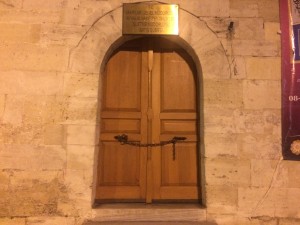
The Olive Oil Shop at Yeni Cami; note that the sign is directly above the door. (Photo October 2015)
According to Avraham, until shortly after the Flotilla Incident, there was a Star of David above the door which is now covered up by the shop’s sign. I initially expressed skepticism about this; but Avraham told me he has seen the Star of David with his own eyes. So I did some digging and I tracked down an older picture of the shop. It does appear that the sign was lowered to cover up some image that appears like it could be a Star of David in some sort of circle. Check it out.
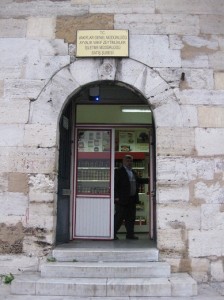
The olive oil shop in November of 2010, note the placement of the sign is not directly above the door, and the image in the stone right below it. The source of this image and a better view is here.
Here is another photo I took of the olive oil shop at night. It appears to me (an untrained eye) that the top of the building was added at a later date.
Here too, if anyone can find a printed source that discusses whether this olive oil shop was once a synagogue (or a religious building) of any Jewish movement, drop me a note.
I also plan to reach out to an expert on the Jews of Istanbul to see if we can shed any light on whether these two structures were once Jewish buildings (Karaite or otherwise).
I leave you with a few more pictures from my trip. Enjoy:
- I met the last Jewish merchant on Istanbul’s major Istiklal street. His landlord, Saint Mary Draperis Roman Catholic Church, is seeking to evict him. He is a Karaite and he is also a Cohen. He has been interviewed by numerous media outlets. In an interview by Almonitor, he once said, “I don’t care what a person’s religion is, whether he is Jewish, Christian or Muslim. I am Karaite Jewish. We believe in tolerance. We believe that all prayers go to the same place. I only care if a person has a good heart or not. But those new priests don’t understand our history. If I lose my shop, I don’t know how I’ll cope. I’m not a rich man.”
- The interior of the Ark/Aron at the Karaite synagogue in Turkey. The Hebrew has the words “Shrine of YHWH,” followed by “Open for me the gates of righteousness; I will go into them, I will thank Yah.” (Ps. 118:19.) A very fitting verse for doors that open to the Torah.
- This sign and many others can be found outside the synagogue.
- Hakham Magdi Shemuel visited the community in Istanbul in 1981 and slaughtered a lamb at this spot just before Passover. The community in Turkey remembers him fondly, and via his son Hazan Eli Shemuel, he sent his regards back to the community.
- Finally, I owe an incredible debt of gratitude to Avraham for showing me around and making sure I was taken care of in Istanbul. He provided me with the oral history of the Karaites in Turkey, and has graciously supported my continued desire to learn about Turkish Karaites.
* * *
[1] For scholarly thoughts on this theory, see Zvi Ankori’s Karaites in Byzantium, p. 144, n.219 (“Needless to say, the above etymology is not cited here as proof of Karaite settlement in that particular section of Galata [in which Karakoy lies]. Rather, it is important as an echo of popular reminiscences regarding the spread of Karaites beyond the limited area described by Benjamin [of Tudela] (and situated in a different part of Galata).”)
[2] In Turkish there is no sound equivalent to the English “h”; so the word Kahal is often spelled and pronounced “Kal” (with both ‘a’s of Kahal blending into one sound).
[3] See http://www.jewish-quarter.org.il/atar-hakrai.asp
[5] See Minna Rozen, A History of the Jewish Community in Istanbul: The Formative Years, 1453-1566, p. 56.
[6] See John Freely, The Companion Guide to Istanbul and Around the Marmara, p. 19 (“The area where Yeni Cami now stands was for centuries a Jewish quarter . . . . The Jews who resided there were members of the schismatic Karaite sect, who broke off from the main body of Orthodox Jewry in the eighth century. The Karaites seem to have established themselves on this site as early as the eleventh century . . . . The Karaites continued living there until 1660, when they were evicted to make room for the final construction of Yeni Cami. They were then resettled some three kilometres up the northern shore of the Golden Horn in the village of Haskoy, where a few of their descendants remain to this day.”). It appears that the Jewish land at Yeni Cami was confiscated after a fire destroyed much of the local infrastructure, allowing for an easier transfer of Jews away from the region. See Minna Rozen, A History of the Jewish Community in Istanbul: The Formative Years, 1453-1566, p. 57.
* * *
No post on Karaites in Turkey is ever complete without a picture of Zvi Ankori’s groundbreaking work, Karaites in Byzantium. I gave a copy of this work to Avraham so that he can share the information with his community.
And while I was in Turkey, one of the local Karaites gave me this book, which I hope to explore and blog about in the future.


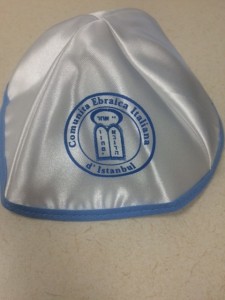
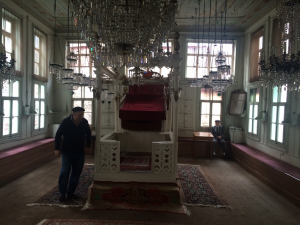

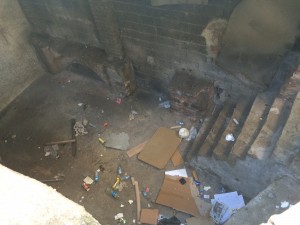
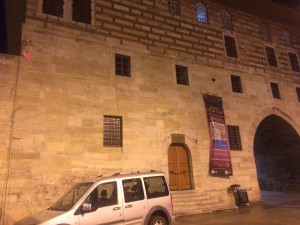

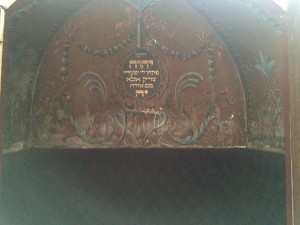
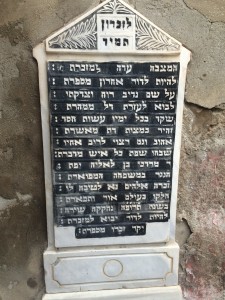
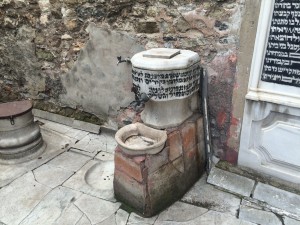
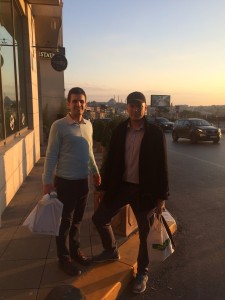

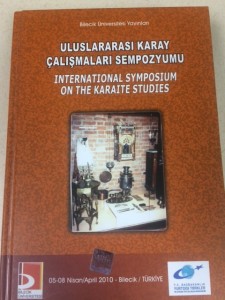

Shalom Shawn!
I loved the article!
Please publish more about your visit in Turkey.
Cheers!
Gal Tamir
Thank you! I plan to.
“Deep in the heart of every Jew you will find Karaite views.” Yes! Yes! Yes!
There are so many aspects of analyzing the history of what are referred to as the Karaite Jews. There are so many misunderstandings and confusion. Some have described recent generations of Karaites as “Anarchist” who claim to only believe in the ability of each and every individual to decide for himself or herself how to conduct one’s life according to the Torah, even without regard to implications for the greater community and community cohesion. After all, if everyone REALLY has the right to decide whatever he/she wants based on understanding, then as we say in Hebrew, Eyn Ledavar Sof – there’s no end to it all, and the result is Anarchy.
But in fact this is not really what was happening for most of history of the Karaites, even (correctly) assuming that they existed long before Islam, back to the time of the Second Temple.
Many of the most famous names of Karaites throughout the generations not only claimed that many of the teachings found in the Talmud were actually correct from a Karaite perspective, but that Torah knowledge had to be transmitted from one teacher to student throughout the generations to maintain integrity, cohesion and what they believed to be was the truth of the Torah.
One need only consult the writings of Simcha of Lutsk, Aharon ben Yosef, Yehuda Hadassi, Moshe Beyzatchi, and others to see that they maintained that in fact there was a transmission of true Torah teachings as oral law, or more correctly, the correct interpretation of the written law in relation to aspects not covered in the Torah itself. This is called Sevel Hayerusha or Ha’ataka.
Thus, we find that the commonly held assumptions in recent generations about the beliefs and traditions of Karaites are totally incorrect and misinterpreted.
If one wishes to take a view of a halachic issue, is it possible that according to any Karaite that G-d would wish his people spending shabbat in cold northern countries should not heat their homes based on “Thou shalt not have fire burning in your dwellings.” Even if they accepted this as the literal law, how does one survive in Russia or Poland in the winter comfortably?! Well, is it possible that they interpreted it to mean that a Jew could “sell” his dwelling to a non-Jew for Shabbat symbolically, and therefore the burning of fire was not in his OWN dwelling at all, but the dwelling of the gentile? I haven’t seen yet full halachic discussion of the issue of cold shabbat, but this is what occurred to me.
Many interesting primary sources over the generations and more recently can be found in the books of people such as Bernard Revel, Prof. Fred Astren, and many others, showing how Karaite scholars ruled on halachic issues in ways not unlike what is found in the Talmud, or according to certain positions taken among talmudic rabbis. It was Aharon ben Yosef in Sefer Hamivchar who clarified that the Talmud according Karaite tradition contained both true teachings of Torah and sages, and teachings that Karaites disapproved of as rabbinical injunctions not based on the Torah itself, which of course is unacceptable to Rabbinical Judaism. But the situation is not as black and white as has been believed about Karaism in recent generation. At least this is what I have found from the teachings of those I mentioned, as well as Tuvia ben Moshe, and others.
I believe the tradition of non-Talmudic Judaism (for want of a better name) did not “originate” with either Anan ben David or any of the people identified in the early history of Yaakov Qirqisani, as people who “emerged” with sects. Frankly, I am not even that certain personally that the book ascribed to Yaakov Qirqisani was done entirely by him given the incomplete and somewhat contradictory description of Karaite history. According to Simha of Lutsk, from about 300 years ago, it was not the case that Anan initiated anything at all, but rather that he reinforced or gave more wide public awareness about the tradition that in fact existed in the time of the Second Temple under the heads of the Sanhedrin recognized by the rabbinical Jews. Indeed, Simha of Lutsk posits that the “semi-rabbinical” tradition (for want of a better term) was the ORIGINAL Jewish tradition since the Torah was given at Mt. Sinai, i.e. the written Torah with its “perushim” together orally, and then was given added rabbinical injunctions at the time of Shimon ben Shetach. However, even Simha of Lutsk does not explain how Shimon ben Shetach and Yehuda ben Tabbai managed to work together as heads of the Sanhedrin OR peacefully transmitted Torah knowledge to the following generations all the way to Hillel and Shammai (the latter being the recipient of the “unaltered” Karaite tradition).
I also question the standard view that certain Karaite scholars changed Anan’s law of incest. Since much of what is known about Anan is from his enemies, perhaps the alternative laws were actually the tradition.
Similarly, conventional scholarship describes the Bayzachi family of accepting Talmudic rulings about being able to use fire on shabbat. But perhaps in fact they were simply presenting their tradition in halacha.
Finally if Salmon ben Yeruham is included in the chain of transmission, then how could his alleged hostility to the Talmud in his book Milhamot Hashem be his authentic teaching and tradition? I have my doubts that the book is truly from him.
Indeed the Karaites of Troki in Lithuania were long known to allow heat with fire and burning candles on shabbat. Does this mean there were two or more Karaite traditions that eventually morphed into one??
Shawn, what is the origin of the Karaites in Istanbul, and how many are there? I have heard that they were neither Crimean nor Egyptian Karaites by origin. Thanks.
I loved the article, which brought some chagrin also. The Karaites of Turkey had similar experiences as the Karaites of Egypt. This story touched me like no other. It brought me back to my previous life when I was a young man. We love our heritage and tradition. Shawn, your documentation is inspiring to say the least. It brings so much goodness that revives the soul. You must have enjoyed the experience. May God bless you and your family.
Thank you.
Can anyone confirm whether Karaites in Europe historically spent winter shabbatot in freezing homes because of the rule of no fire during shabbat? Was there no legitimate loophole as I suggest, about selling one’s home for shabbat to a gentile, or other alternative?
On second thought I would bet that there was never a consensus about the prohibition of fire, and that the majority of Karaites from earliest times did NOT spend Shabbat night in the dark, and freezing in the winter! Can anyone address this?!
I think…I could be wrong you know..but if you really think about it, would not the sanity of life be truly more important than keeping halacha…speaking for those who were/are living in the colder in the upper north part in Europe during the winter…? So yet a fire would most likely be a source of protection from the bitter cold…as well is to be dressed warmly….? Respectfully, Dale
I’m still waiting for an informed response from someone familiar with Karaite history.
Shalom,
On my phone I don’t see a way to contact you directly but if you could email me back I would really appreciate it.
I visited the karaite synagogue when I was in Istanbul 2 years ago and it’s truly extraordinary.
A caretaker was the one who let me in however and I did not have the chance to meet anybody from the Karaite community.
Could you email me the phone number of somebody I could contact? A Karaite friend is currently in Istanbul and interested in joining for a tfilah over the high holidays.
Thanks very much!
Moshe
very interesting!…since I am of Istanbul karaite ancestry I am also looking for people of this community to contact…
Moshe have you succeed to obtain contacts ?
Let me know
Thank you very much !
Sarah
Thanks for your article. In regards to your question about the authenticiy of Yeraltı Cami as built upon a Kariate site, yes, this is possible based on the 3rd observation re: prostration. One of the features of Kariate ritual is that they DO prostrate thenselves on rugs on the ground. Re: the question of the Star of David over what is now an olive oil store—I also saw Yeni Cami back in 1992 and that door did have a Star of David over it. I remember wondering about why a Cami door would have the six pointed star.
I have also heard the story from older Istanbul Jewish residents re: the origins of Karaköy as a formerly Kariate village.
Cheers!
Very to well written and a wealth of knowledge. Thanks fir sharing it.
I would like to speak with you. Please contact me: rabbiari@hotmail.com or WhatsApp +972 58 579 1773
Thank you!
Rabbi Ari Enkin